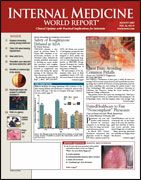Home-Based Bone Density Testing Useful in the Elderly
By Jill Stein
BARCELONA, Spain—At the European League Against Rheumatism annual meeting, investigators reported early favorable results with domiciliary heel bone density assessment used to screen for osteoporosis in home-bound elderly patients.
The heel dual-energy x-ray absorptiometry—so-called heel scan—may prove to be a useful method for evaluating very elderly patients who, for whatever reason, do not visit their physician or clinic for routine hip and bone scan screening.
"Our results suggest that we can boost the rate of participation for osteoporosis screening using home assessment and?that a heel scan is feasible," said Fraser N. Birrell, MD, consultant and senior lecturer in rheumatology at the University of Newcastle.
"While persons 85 years of age and older are the fasting-growing sector of the population, with high rates of pain and disability at significant financial cost, we were interested?in identifying patients who reach a ?ripe old age' without developing significant pathology," Dr Birrell pointed out.
The research in this population is scarce, he said. And the research that has been done may not be reliable. "Doctors often visit these patients at their home or in nursing homes, where there is often no access to investigative facilities. When we do population studies, only about a third of patients are well enough to come to the hospital for the study. This means we have a large potential selection bias on any research data we gather."
Some 167 individuals aged ≥85 years were invited to attend a local hospital for comprehensive musculoskeletal assessment involving scans of the lumbar spine, bilateral femoral neck, and whole-body mineral content, as well as a heel scan.
Those who declined hospital assessment were offered a home visit that included a heel scan. Overall, 48 responders came to the hospital forfull assessment, and 29 had a domiciliary assessment.
"Heel bone density as a screen for osteopenia and osteoporosis performed well in this age-group," Dr Birrell noted. The positive predictive value was 62% for osteoporosis and 83% for osteopenia.
This study is the first to validate the use of the heel scan for osteoporosis and osteopenia screening in this age-group, according to Dr Birrell. He emphasized that these results need to be confirmed in a much larger study.
He stressed that these results do not mean elderly people should renounce the conventional screening method. "The hip and spine scanner is preferable in a patient who is well enough to go to a place where there is a hip and spine scanner," he said. "If a patient is not well enough to travel to a clinic or hospital where there is full scanning, then there is justification for doing the heel scan."
It is important to identify ways to reach people who have had to forego screening, because they cannot travel to a screening site, he noted.
"If people can't come in for screening, the danger is that they'll be undertreated," Dr Birrell said. "Our worry is that these are the sickest people and thus the ones who are most in need, and yet they aren't being treated. That's why it may be necessary for the doctor to go to the patient rather than the patient to the doctor."
